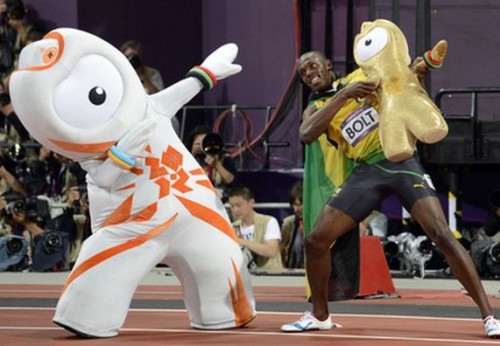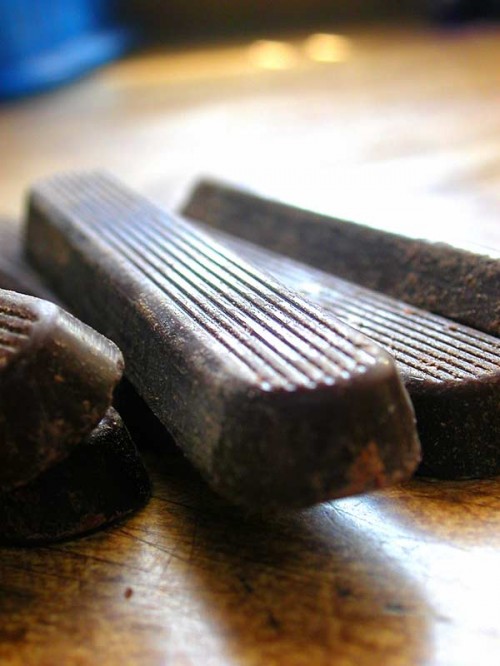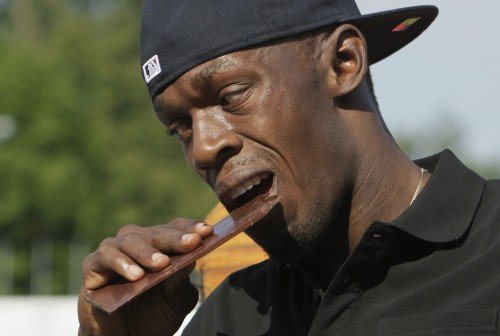Chocolate Olympics 2012

Jamaican runner Usain Bolt strikes his signature lightning bolt pose with Olympic mascot Wenlock and mini-stuffed-Wenlock after winning gold in the 100m.
If you were like me and followed the London 2012 Olympics with great enthusiasm, chances are that you’re feeling a bit of a void in your life now that the Games are over. So here’s a retrospective of a story that NBC didn’t cover: the chocolate Olympics.
Chocolate sponsorship
Kraft/Cadbury was an “official sponsor” and the “official treat provider” for the London games, the only chocolate company allowed that status (Mars was the “official chocolate” of Beijing 2008), and launched a 50 million pound marketing campaign as a result. The campaign included printing the London 2012 logo on Cadbury products, selling chocolates made in the shape of the rather odd Olympic mascots, and crafting a social media strategy to amp up support for Great Britain’s athletes.
In typical Cadbury fashion, the marketing was quirky. The interactive online tool “The Cadbury Choculator” allows users to generate Games statistics in chocolatey measurements. For example, I learned that “The London 2012 Olympic Swimming pool is 208 wonderful Cadbury Dairy Milk bars wide” and “In Olympic Trampolining the gymnasts perform tricks at whopping 500 Cadbury Crunchie bars high.”
Cadbury also returned to its stop motion Crème Egg video style for the Games with an Olympic-themed “Let the Goo Games Begin” campaign:
Other chocolate companies were unofficially involved with the Games, by sponsoring athletes as “brand ambassadors,” setting up treat stands around London, and releasing products in “the spirit of” the Olympics. Regulations around the use of the Olympic symbols are strict, though, and unsanctioned uses, like those of bakers making bagels or cakes displaying the Olympic rings, were subject to accusation of trademark infringement. But, as is often the case, there were ways around the rules, and people who knew where to ask could still find plenty of chocolate diversity thanks to the thriving black market in the Olympic Park.
Chocolate and fitness
One aspect of the chocolate Olympics merits further discussion than it got in the mainstream press this year — the ethics of promoting candy to children, especially when linking it with fitness. While many enjoy debating the efficacy of advertising regulations, there is significant evidence demonstrating the harmful health consequences of advertising to kids. Cadbury seems to have chosen a different strategy this year due to bad press around childhood obesity in the past, focusing its marketing push on game-playing rather than chocolate consumption. Still, plenty of marketing to kids took place during the Olympics and will continue in the future, and some of it included chocolate.
The average person should never model their diet after elite athletes who eat up to 12,000 calories a day to keep up with their workout regime. The vast majority of us simply don’t move around enough to need that much food. It’s therefore all the more unfortunate that the sponsorships elite athletes rely on to support themselves financially so often compromise basic nutritional wisdom. (Even American swimmer and eleven time Olympic medalist Ryan Lochte sought out a healthier training diet after feeling that he could have performed better in the 2008 Beijing Olympics without typical breakfasts of “two or three McDonald’s egg McMuffins, some hashbrowns and maybe a chicken sandwich.”)
Several USA Swimming team members hawk chocolate milk for big bucks from the Refuel With Chocolate Milk campaign. I’d need to swim for 30 minutes to burn off the calories in the average serving of low-fat chocolate milk, and the sugar content is as high as in many sodas. Even beloved Massachusetts-based Team USA gold medal winning gymnast Aly Raisman is selling chocolate milk as “the best combination of carbohydrates and protein” for post-workout muscle recovery. Given the excessive sugar content, poor quality of the chocolate, and the mounting evidence against heavy milk consumption for health, the suggestion that this is an ideal post-workout drink for an average person is absurd.
Olympian love for chocolate
Of course, it wasn’t all marketing and sponsorships at the chocolate Olympics. Several Olympians went on the record about their love for chocolate “just because.” Great Britain’s medal winning triathletes the Brownlee brothers have been inspired by chocolate since childhood, Great Britain’s gold medalist heptathlete Jessica Ennis looks forward to splurging on chocolate on her weekly cheat days during training, the USA’s all around gymnastics gold medalist Gabby Douglas enjoys “all kinds of chocolate,” and India’s medal winning badminton player Saina Nehwal said “I’m going to eat a lot of chocolate now. It’s okay if I put on some weight,” when asked what her plans were after the Games. Team USA’s lightweight rower, Nick LaCava, who is 6’3″ tall and, incredibly, weighs in at 156 pounds on race days, has a chocolate business background. He was a co-founder of customizable chocolate bar company Chocomize before living out his Olympic dream.
Let’s keep it real
The oldest Olympic torch bearer at these Games, 100-year-old Diana Gould, shared the key to long life with the UK’s Telegraph. According to her century of wisdom, one can live a long and happy life with a good attitude, healthy habits that include lots of walking, and a bit of chocolate each day.
Usain Bolt was awarded a huge chocolate bar in the Czech Republic’s Golden Spike athletics event in May 2012 and went on to win three gold medals in the London Olympics (there’s a cute video of tiny children racing against him and then sharing chocolate here). As delicious as that chocolate might have been, it was not responsible for making him the fastest man in the world. Twice. Nor should chocolate companies suggest that it was.
A Chocolatey Harvard GSC Mini-Course

chocolate sticks by chotda
Happy Monday to all!
Harvard’s Graduate School of Arts and Sciences offers an interesting selection of short term courses, panel discussions, and workshops every January. As part of this robust programming, a number of mini-courses taught by and for graduate students are chosen and sponsored by the Harvard Graduate Student Council.
This month, I’ll be teaching a course entitled Chocolate, Culture, and the Politics of Food to a group of fellow graduate students from a wide variety of disciplines. The description and a brief outline of what we’ll cover is below.
Class begins today and I’m optimistic that we will have a delicious first meeting. Updates to come over the next couple of weeks. In the meantime, do let us know what you think of the course description.
Chocolate, Culture, and the Politics of Food
This course will examine the sociohistorical legacy of chocolate, with a delicious emphasis on the eating and appreciation of the so called “food of the gods,” the focus of course instructor Carla Martin’s blog, Bittersweet Notes. Course participants will learn about the history of cacao cultivation and the present day state of the chocolate industry; the science behind cacao and chocolate; the diverse cultural constructions surrounding it; the economic forces that have come to largely control it; and the implications of international politics, the food movement, and alternative trade models for its future. We will ask questions of chocolate related to racial and socioeconomic injustice, responsible development, honesty in production and marketing, hierarchies of quality, and myths of purity. Participants in this mini-course can also expect to learn to better identify chocolate that suits their individual tastes, cravings, cooking ambitions, and ethics. Course participants will be asked to contribute approximately $20 to cover the cost of chocolate for tasting (this dollar amount will depend on enrollment).
Course details
Our main reference text will be The New Taste of Chocolate: A Cultural & Natural History of Cacao with Recipes (2009) by Maricel Presilla. Optional supplemental readings will be made available, with directed recommendations from the instructor. All course meetings will involve multimedia presentation and discussion, with special attention given to the utility of digital research tools, blogging, and social media for learning and research on chocolate.
In addition, we will taste chocolate at each course meeting, working to train our palates to begin to recognize different types, origins, and compositions of chocolate. It will become clear that sociohistorical context is most often inseparable from the resulting flavor and quality of chocolate. Our sixth course meeting will combine presentation and discussion with visits to local chocolatiers and chocolate makers in the Cambridge area. An optional seventh meeting for a tour and conversation at Taza Chocolate factory in Somerville will be scheduled at a time convenient for the group.
The course is divided into six two-hour meetings, each devoted to one part of chocolate’s story:
1. Sociohistorical legacy of cacao and the rise of the global chocolate industry. Chocolate in culture: as food, currency, medicine, royal privilege, aphrodisiac, entertainment, luxury, etc. Examples will be drawn from history, literature, music, art, and film, and will highlight chocolate’s relationship to social issues like race, gender, sexuality, post colonialism, and international politics.
Tasting: single origin, single bean Latin American chocolate.
2. The science of growing and identifying cacao varieties, geographic and environmental requirements, chemistry and physics of chocolate making, and health benefits and concerns in chocolate.
Tasting: single origin chocolate from around the world.
3. Chocolate industry monoliths, scandal, and intrigue. The ongoing saga of big agriculture, multinational corporations, international relations, commodity trading, labor rights and abuses, and enormously powerful brands.
Tasting: some of the world’s most popular chocolate bars.
4. Pastry chefs, chocolatiers, craft chocolate makers, and chocolate connoisseurs. The food movement participants driving current innovations in chocolate and working to preserve some of the world’s heritage cacao varieties.
Tasting: industry-changing, cutting-edge craft chocolate bars and artisanal bonbons.
5. Chocolate, food advocacy, and social media – where international politics, the food movement, food politics, and alternative trade models meet.
Tasting: chocolate marketed as fairly traded and ethically sourced.
6. Chocolate in the Boston area, from the revolutionary era to the present. The history of Baker’s Chocolate in Dorchester (first to produce chocolate in the United States), NECCO’s candy row in Cambridge (do you smell Tootsie Rolls?), and a visit to local chocolatiers and chocolate makers.
Tasting: chocolate from local chocolatiers and chocolate makers.


